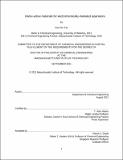Redox-active materials for electrochemically-mediated separations
Author(s)
Tan, Kai-Jher
DownloadThesis PDF (34.67Mb)
Advisor
Hatton, T. Alan
Terms of use
Metadata
Show full item recordAbstract
Separation processes are ubiquitously employed for purification purposes in chemical production, as well as potable water generation and environmental remediation. The rising intensity of global issues such as the growing world population, low water security, and worsening industrial pollution all necessitate further advancement in the discovery, development, and application of materials for separations. Electrochemical approaches are an attractive alternative due to the innate propensities of redox-active species for modular design, molecular recognition, reversible operation, and lower energetic requirements, all of which can be realized via only electrochemical stimuli without any chemical additives. In this work, the focused design of redox-active materials for imparting specific functionalities to electrosorption processes are discussed.
Redox-active composite materials have been developed from four different classes of electroactive species in order to enable redox-mediated ion detection and removal in water, with designed controllability over their pseudocapacitances, stabilities, analyte selectivities, and energetics. Anion separation was achieved using an organometallic ferrocene co-polymer whose electrochemical activity in different electrolyte solutions can be manipulated based on its co-monomer. Through principles of hydrophobicity, the metallopolymer can be engineered to activate in the presence of hydrophilic anions instead of hydrophobic ones, for subsequent application in the stable and 17-fold selective electrochemical extraction of perrhenate over nitrate. The ferrocene macromolecule motif was also extended to the generation of zwitterionic polyelectrolytes that possess pH-sensitive electrochemical behavior in both homogeneous and heterogeneous environments. Cation separation was facilitated through the preparation of pH-dependent quinone and electronically-tunable crystalline hexacyanoferrate-based conductive electrodes, which were paired together with polymeric ferrocenes to produce asymmetric redox-active systems that were able to reduce the extent of anode fouling and current leakage by preventing parasitic water reduction, offer optimizable separation energies based on solution conditions as well as the selected anode-cathode couple, allow for the enhanced and simultaneous recovery of transition and alkali metal compounds without altering their bulk oxidation state, and enable continuous operation under flow conditions. Lastly, redox-active components were incorporated into a particulate scaffold instead of an electrode framework with the purpose of further improving their potential for ion separation through heightened maneuverability and phase contact provided in part by the judicious variation of material hydrophilicity. Specifically, polypyrrole and polyferrocene-containing magnetic composites were synthesized through a facile multi-step procedure, and exhibit strong adsorption capacities for both inorganic and organic contaminants.
Date issued
2021-09Department
Massachusetts Institute of Technology. Department of Chemical EngineeringPublisher
Massachusetts Institute of Technology